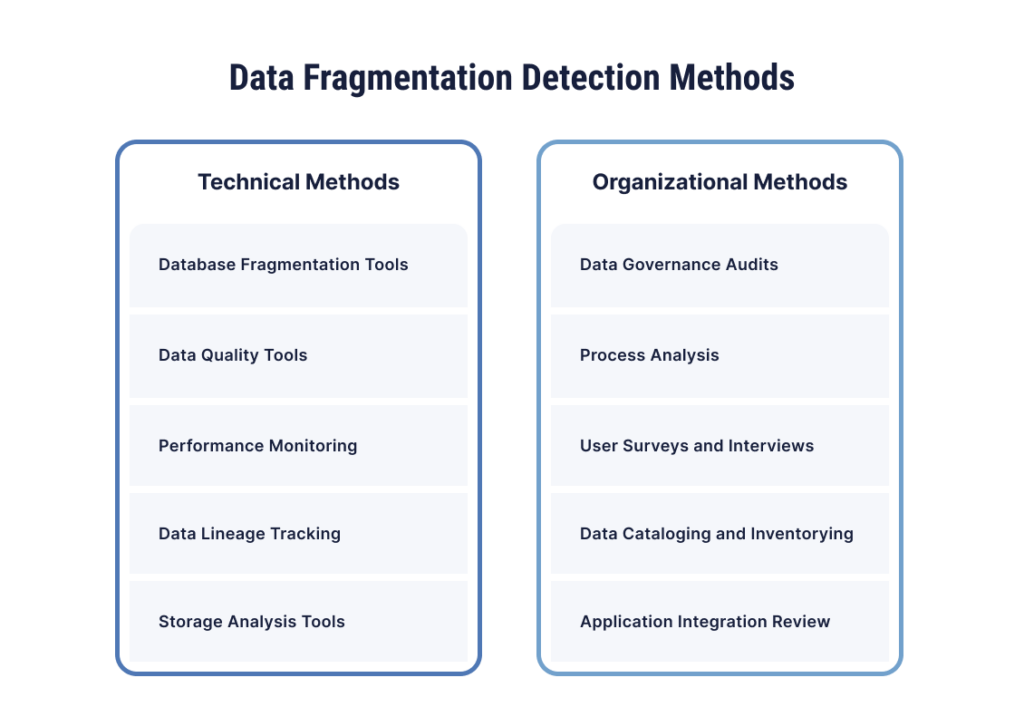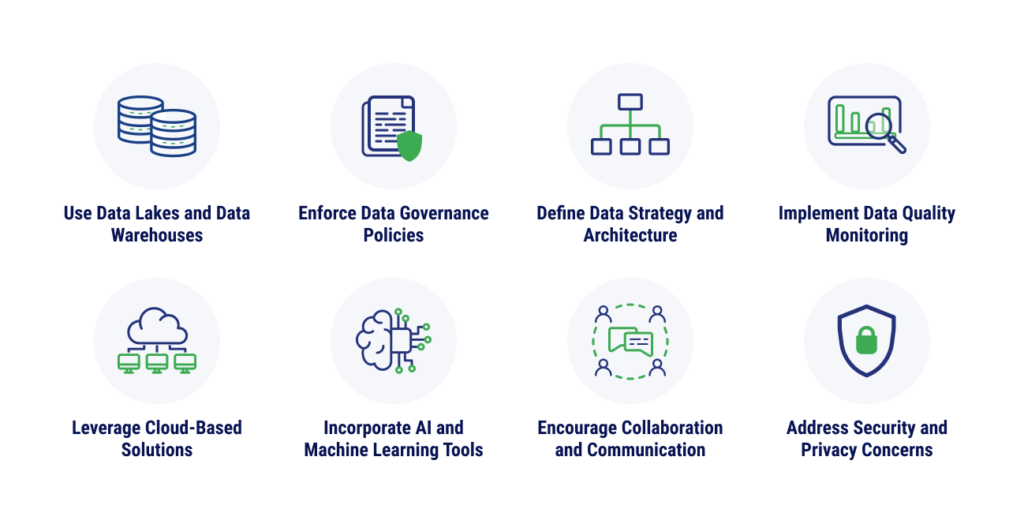
Edward Tufte, a statistician and data visualization expert, speaks about how comprehension of data decreases every time we have to flip a page to compare two sets of information. Proximity is the key to forming relationships between data. When data is siloed and segmented in different areas, this fragmentation makes it difficult, and sometimes even impossible, to form these relationships. Below, we’ve outlined eight strategies businesses can use to overcome data fragmentation challenges and get the most out of the data that may be just out of reach.
What is Data Fragmentation?
Data fragmentation is when an organization’s data becomes spread across different systems, applications, and storage locations. While the data may function as intended for individual tasks, its dispersed, siloed nature can make it more difficult to manage, analyze, and integrate effectively. While it’s similar to the issue of fragmentation within database management systems (DBMS), data fragmentation does not just refer to the physical storage of data within a database in non-contiguous blocks, but instead, is a system-wide problem.
Types of Data Fragmentation
The main problem with data fragmentation is rooted in scattering and silos. Isolated data silos may be created by different departments or teams without thinking about wider coordination. Data fragmentation is generally categorized into two main types: physical and logical.
- Physical Fragmentation: With physical fragmentation, data is scattered across different locations or storage devices. It can be time-consuming and technically difficult to integrate data.
- Logical Fragmentation: This type of data fragmentation happens when data segments can be logically duplicated or divided across different applications or systems. This can mean that different versions of the same data are available in different locations.
What Causes Data Fragmentation?
There are both technical and non-technical causes for data fragmentation. When businesses have storage inefficiencies, inconsistent naming conventions, or issues with data format standardization, physical and logical fragmentation can occur. Data fragmentation can also come from security restrictions that form barriers to integration and data sharing.
On the non-technical side, the failure to have a vision for data collection, processes, and utilization can lead to fragmentation issues through practices such as decentralized data storage. When each department or team creates its own siloed data solutions, accessibility and format consistency can suffer.
These problems can be exacerbated when there is a reactive instead of proactive response to immediate needs, creating more fragmentation instead of sustainable architecture. A short-term focus or working on rapid app adoption without planning can be part of “shiny object syndrome” or just short-sighted planning, where companies pursue new technologies and applications without thinking about how data will integrate or be accessed.
Data islands can be created accidentally, such as in the case of rapid adoption, or can be part of information ownership disputes. Departments may engage in “turf wars,” feeling that they need control over their data and hoarding it as a result. Businesses may also suffer from unclear data ownership and ambiguity that negatively impacts information sharing and further collaboration.
Organizations can also be hampered by their systems. Legacy systems are sometimes incapable of interacting with modern tools. Proprietary formats may have inconsistent formats and standards that don’t work well with widely used tools outside of the business. It’s easy to get discouraged when efforts to integrate legacy systems feel too costly and time-consuming.
Another issue can arise from an inability to handle unstructured or semi-structured data effectively. When unstructured data outpaces storage and organization methods, the data explosion can quickly lead to fragmentation. Some traditional systems are also unable to handle the complexity and variety that comes with modern unstructured data.
How Do You Detect Data Fragmentation?
Technical and organizational indicators can be used to detect data fragmentation.

More technical methods can include using database fragmentation tools, data quality tools, performance monitoring, data lineage tracking, and storage analysis tools. These tools can be used to find inconsistencies, chart the flow of data, analyze response times across file systems, and identify patterns in storage allocation and usage.
Organizational detection methods businesses may use include performing data governance audits, doing process analysis, conducting user surveys and interviews, creating catalogs and data inventories, and reviewing how applications are currently integrated. By gathering data on an organizational level, businesses can figure out where fragmentation risks may exist, where internal employees are seeing challenges in access or integration, and where current gaps need to be closed.
What’s the Impact of Data Fragmentation?
Because the big problem at the root of data fragmentation is scattered information, the impact on each industry depends on what that fragmentation is most likely to cause, and how costly that consequence will be. In the case of healthcare, for example, data fragmentation can cost tens to hundreds of billions of dollars per year and result in misdiagnosis, duplicate services, and inappropriate or excess medications. For finance, fragmented data can cause major compliance issues and put customer information at risk.
8 Strategies to Solve Data Fragmentation
Below, we’ve listed eight helpful tips to help resolve data fragmentation challenges.

Use Data Lakes and Data Warehouses
Instead of having data stored in disparate places, consider consolidating it in the form of data lakes or data warehouses. Raw data can be stored in data lakes and processed in aggregate later to uncover new insights. Structured data can be stored in data warehouses, where businesses can move to the analysis stage much more quickly. These repositories can help achieve comprehensive data analysis and exploration while handling diverse data types.
Enforce Data Governance Policies
Effective data management stems from establishing and enforcing clear policies for data access, quality, and usage across an organization. As data is managed and accessed throughout its lifecycle, certain policies need to be in place for how it will be handled and protected. Governance measures can include defining roles and responsibilities for how data should be used and stored, who has ownership over certain data, who has access to different sets of data, and how standards of quality will be maintained.
Define Data Strategy and Architecture
Managing different types of data effectively across lifecycles requires a solid roadmap. Consider what challenges may arise down the road and how your business can address them ahead of time by having a clear picture of your data architecture and overall strategy.
By understanding your current landscape, where you may be heading in the future, and what kind of architecture is required to get you from point A to point B, you can meet and move with
changing demands and be more prepared for potential challenges, such as emerging technologies, data growth, and new data sources.
Implement Data Quality Monitoring
Ensure data accuracy, completeness, and consistency across the entire ecosystem by implementing data quality monitoring processes. Data quality is an important part of your overall data resilience, improving your accuracy, consistency, and completeness across a data ecosystem. Monitoring can help you identify anomalies, clean your data, validate what’s in your environment, and identify issues before they lead to greater fragmentation.
Leverage Cloud-Based Solutions
Cloud platforms provide scalability, flexibility, and access to advanced data management tools that businesses need to tackle data fragmentation head-on. When you migrate data to the cloud, you can centralize your storage, work toward data integration, and employ built-in tools that help with governance, data quality, and analytics.
Incorporate AI and Machine Learning Tools
Quality checks and data monitoring can be efficiently accomplished through artificial intelligence and machine learning (AI/ML) tools. Automate quality checks, quickly find hidden anomalies and patterns and use established data and rulesets to find fragmentation risks.
Encourage Collaboration and Communication
While data fragmentation may seem like solely an IT concern, fostering collaboration between IT, business units, and data owners is vital to keeping the problem at bay. Collaboration ensures alignment between key players, and businesses may want to go as far as implementing company-wide standardization measures, such as data formats, naming conventions, definitions, and protocols. These standards minimize inconsistencies, and, by extension, fragmentation.
Address Security and Privacy Concerns
When integrating new data sources, it’s important to consider security and privacy concerns that may arise from these sources. Implementing secure access controls, data encryption, and threat detection and monitoring, along with monitoring and governance measures, can mitigate security issues.
What Are the Benefits of Resolving Fragmentation Issues?
Just like it’s easier to throw random items into a closet and forget about them, it takes a lot more effort to organize data and resolve fragmentation issues than it does to keep living with them, but businesses that take the time to fix fragmentation can enjoy many benefits:
- Greater Data Quality and Consistency: When data is more centralized, you significantly reduce or eliminate duplicate entries, improving the reliability and accuracy of your data. Standardizing data formats and reducing inconsistencies allows for smoother data analysis and integration.
- Improved Decision-Making: When proximity improves, it’s easier to make data-driven decisions and form relationships between different points. Unified data makes it easier to see patterns and trends that lead to more strategic choices.
- Increased Productivity: While the upfront work can be time-consuming, eliminating data fragmentation will reduce the amount of time it takes to locate and integrate data long-term.
- Cost Savings: Reducing redundancies and increasing operational efficiencies all lead to cost savings. Data fragmentation can also mean resource allocation isn’t as effective as it could be, so improving fragmentation can also mean better resource allocation.
- Better Compliance Management: When data is simplified, compliance also improves by enabling better privacy controls and more straightforward data security measures.
- More Collaboration: Collaboration and communication across teams can improve once the silos to data are broken down. Unified data also ushers in new opportunities for innovation.
TierPoint Helps Build the Right Plan and Solve for Data Fragmentation
Once you understand the challenges of data fragmentation, the benefits of improving fragmentation, and the steps for how to get there, you’re well on your way to building a plan that will work for your business. You can choose to work on one data source at a time or engage in an organization-wide overhaul. Either way, it’s important to handle data fragmentation without causing other disruptions to business processes, and that’s where TierPoint’s data and analytics consulting services can lend a hand. We can help you reach better business outcomes by making the most of what’s already available in your data.
